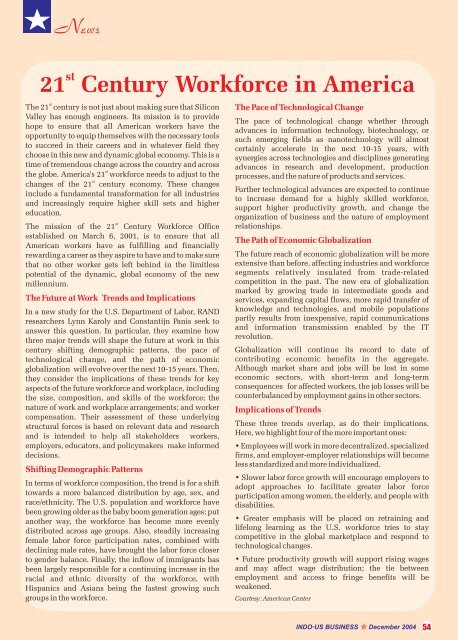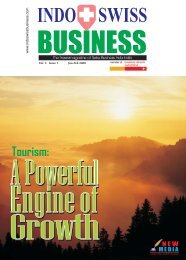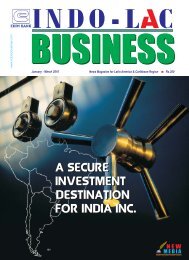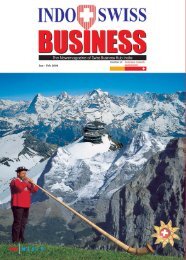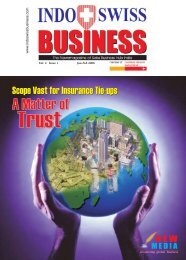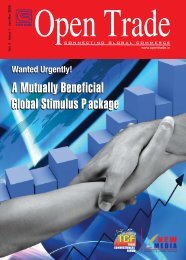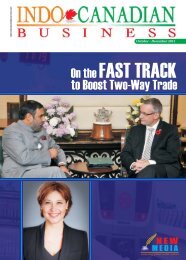Indo-US Partnership - new media
Indo-US Partnership - new media
Indo-US Partnership - new media
You also want an ePaper? Increase the reach of your titles
YUMPU automatically turns print PDFs into web optimized ePapers that Google loves.
News<br />
st<br />
21 Century Workforce in America<br />
st<br />
The 21 century is not just about making sure that Silicon<br />
Valley has enough engineers. Its mission is to provide<br />
hope to ensure that all American workers have the<br />
opportunity to equip themselves with the necessary tools<br />
to succeed in their careers and in whatever field they<br />
choose in this <strong>new</strong> and dynamic global economy. This is a<br />
time of tremendous change across the country and across<br />
st<br />
the globe. America's 21 workforce needs to adjust to the<br />
st<br />
changes of the 21 century economy. These changes<br />
include a fundamental transformation for all industries<br />
and increasingly require higher skill sets and higher<br />
education.<br />
st<br />
The mission of the 21 Century Workforce Office<br />
established on March 6, 2001, is to ensure that all<br />
American workers have as fulfilling and financially<br />
rewarding a career as they aspire to have and to make sure<br />
that no other worker gets left behind in the limitless<br />
potential of the dynamic, global economy of the <strong>new</strong><br />
millennium.<br />
The Future at Work Trends and Implications<br />
In a <strong>new</strong> study for the U.S. Department of Labor, RAND<br />
researchers Lynn Karoly and Constantijn Panis seek to<br />
answer this question. In particular, they examine how<br />
three major trends will shape the future at work in this<br />
century shifting demographic patterns, the pace of<br />
technological change, and the path of economic<br />
globalization will evolve over the next 10-15 years. Then,<br />
they consider the implications of these trends for key<br />
aspects of the future workforce and workplace, including<br />
the size, composition, and skills of the workforce; the<br />
nature of work and workplace arrangements; and worker<br />
compensation. Their assessment of these underlying<br />
structural forces is based on relevant data and research<br />
and is intended to help all stakeholders workers,<br />
employers, educators, and policymakers make informed<br />
decisions.<br />
Shifting Demographic Patterns<br />
In terms of workforce composition, the trend is for a shift<br />
towards a more balanced distribution by age, sex, and<br />
race/ethnicity. The U.S. population and workforce have<br />
been growing older as the baby boom generation ages; put<br />
another way, the workforce has become more evenly<br />
distributed across age groups. Also, steadily increasing<br />
female labor force participation rates, combined with<br />
declining male rates, have brought the labor force closer<br />
to gender balance. Finally, the inflow of immigrants has<br />
been largely responsible for a continuing increase in the<br />
racial and ethnic diversity of the workforce, with<br />
Hispanics and Asians being the fastest growing such<br />
groups in the workforce.<br />
The Pace of Technological Change<br />
The pace of technological change whether through<br />
advances in information technology, biotechnology, or<br />
such emerging fields as nanotechnology will almost<br />
certainly accelerate in the next 10-15 years, with<br />
synergies across technologies and disciplines generating<br />
advances in research and development, production<br />
processes, and the nature of products and services.<br />
Further technological advances are expected to continue<br />
to increase demand for a highly skilled workforce,<br />
support higher productivity growth, and change the<br />
organization of business and the nature of employment<br />
relationships.<br />
The Path of Economic Globalization<br />
The future reach of economic globalization will be more<br />
extensive than before, affecting industries and workforce<br />
segments relatively insulated from trade-related<br />
competition in the past. The <strong>new</strong> era of globalization<br />
marked by growing trade in inter<strong>media</strong>te goods and<br />
services, expanding capital flows, more rapid transfer of<br />
knowledge and technologies, and mobile populations<br />
partly results from inexpensive, rapid communications<br />
and information transmission enabled by the IT<br />
revolution.<br />
Globalization will continue its record to date of<br />
contributing economic benefits in the aggregate.<br />
Although market share and jobs will be lost in some<br />
economic sectors, with short-term and long-term<br />
consequences for affected workers, the job losses will be<br />
counterbalanced by employment gains in other sectors.<br />
Implications of Trends<br />
These three trends overlap, as do their implications.<br />
Here, we highlight four of the more important ones:<br />
• Employees will work in more decentralized, specialized<br />
firms, and employer-employer relationships will become<br />
less standardized and more individualized.<br />
• Slower labor force growth will encourage employers to<br />
adopt approaches to facilitate greater labor force<br />
participation among women, the elderly, and people with<br />
disabilities.<br />
• Greater emphasis will be placed on retraining and<br />
lifelong learning as the U.S. workforce tries to stay<br />
competitive in the global marketplace and respond to<br />
technological changes.<br />
• Future productivity growth will support rising wages<br />
and may affect wage distribution; the tie between<br />
employment and access to fringe benefits will be<br />
weakened.<br />
Courtesy: American Center<br />
INDO-<strong>US</strong> B<strong>US</strong>INESS December 2004<br />
54


